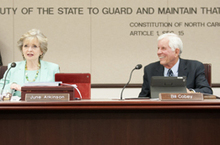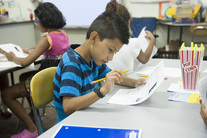 Fall Planning Retreat
ASU Hosted Discussions on Future Priorities
Board members visited Appalachian State
University in Boone on Oct. 4-6 to hold their biannual planning session.
The session focused on ways to expand
or strengthen interagency collaboration to better support students’ access to a
sound education, the implications of District and School Transformation work to
improve low-performing districts and schools, the development of North
Carolina’s Every Student Succeeds Act plan and implications
that all of this has on the 2017-19 budget request.
The information and conversation from
this session will inform State Board actions in the months ahead. A one-day
condensed business meeting followed the Board’s planning session.
|
 Four-Year Cohort Graduation
Rate Highest Ever
High school graduation is a basic, foundational achievement for students as they move into adulthood and prepare to be productive citizens. To that end, the State Board of Education has set a long-term 100 percent graduation rate goal and a short-term 90 percent goal to reach by 2018.
So how are North Carolina public school students doing? In 2016, the state’s overall four-year cohort graduation rate was the highest in state history – 85.9 percent, up from 68.3 percent in 2006, the first year of cohort rate tracking, but short of the 87.5 percent goal for 2016. Among the school districts, 44 met the state goal and 71 did not meet it. This information is included in a report on this topic approved this month for submission to the General Assembly.
|

Report Provides Initial Information on Local, State
Testing
The State Board of Education received an initial report on
the quantity, timing and type of locally required and state-required testing
for students. This report, required by July 2016 legislation, showed that most
districts require some level of local student testing or assessments in
addition to those required by the state to meet federal and state laws on
accountability.
What was learned? Most – 87 percent – of local tests are
benchmarking or interim tests designed to measure student progress on the way
to mastery. Benchmarking is used across a variety of subjects: reading, English
language arts, mathematics and science.
Local testing is most common in
September/October, January and March-May.
|
Teacher Bonuses are Central to Three New Pilot Programs
The General Assembly’s 2016 appropriation bill included three pilot programs to provide teachers in certain circumstances with financial bonuses based on student performance. In October, the State Board of Education discussed policy changes to implement the three pilot programs, outlined below. Action is anticipated on these policies in November.
• Teachers would receive bonuses of $50 per Advanced Placement/International Baccalaureate exams taken by their students and receiving a grade of 3 or above (AP) or a grade of 4 or above (IB). There is a maximum of $2,000 per teacher per year. This first round is based on exams taken in the 2015-16 school year, and bonuses would be payable in January 2017 for the first time. A total of $4.3 million was appropriated for this purpose.
• Career technical education teachers would receive bonuses ranging from $25-$50 per student earning an approved industry certification or credential as defined and valued by the Department of Commerce in concert with the State Board of Education. This bonus also is capped at $2,000 per teacher per year and would be payable in January 2017 for the first time based on 2015-16 credentials earned. A total of $600,000 was provided for this program.
• Third grade teachers in the top 25 percent of teachers in the state (based on the Education Value-Added Assessment System (EVAAS) student growth index score for third-grade reading from the previous year) would be eligible for bonuses. Of the $10 million provided for this purpose, $5 million is to be allocated equally among qualifying teachers and $5 million will be proportionally based on average daily membership for each local school district and then distributed equally among qualifying teachers in each school district. These also would be paid in January 2017 for the first time.
Funding for these pilots is recurring.
|